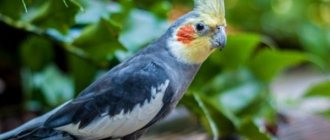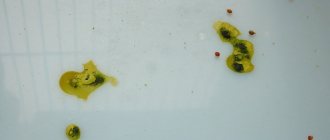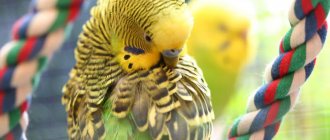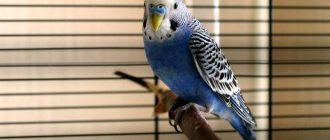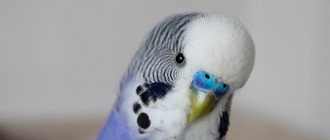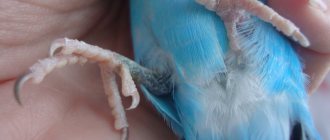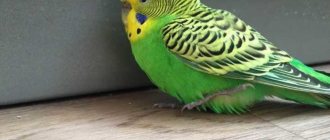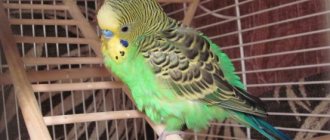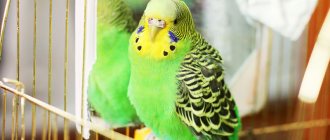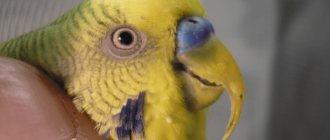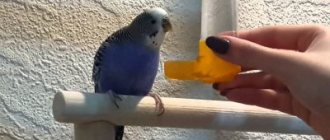Should a parrot be released from its cage?
Some owners of budgies believe that a spacious cage is enough for their pet, from which it is not necessary to let it out.
Indeed, a spacious cage is most preferable for a bird, however, while in it, it experiences a lack of movement.
Even if you pay attention to your pet’s relatives living in the wild, you will notice that they can make fairly long, long-distance flights.
Physiologically, a domestic budgerigar is no different from one living in the wild. Therefore, flights are simply mandatory.
However, among some owners there is another extreme, when their pets have free access to flights, and the cage is never closed. Here, first of all, you should remember the safety of the parrot.
The fact is that many things in an apartment or house can be dangerous for a pet. Here are some recommendations on how to protect birds.
- Close all windows and vents . The greatest danger to a pet parrot is from open windows. The fact is that a bird can easily fly out of the apartment, but, for obvious reasons, will not be able to return. In this regard, you need to carefully ensure that while the parrot is walking around the apartment, all windows and other paths leading to the street are closed.
- Remove dangerous items. Piercing, cutting, heating, and switched-on electrical objects and equipment can be dangerous for a parrot. The bird may be injured if it comes into contact with them. In this regard, the owner needs to remove them from the pet’s reach. In addition, it is not allowed to have open electrical wiring in the room where the parrot will be.
- Avoid contact with indoor plants. A parrot may show an unhealthy interest in indoor plants. Some of them are poisonous to birds, and accordingly, their consumption is fatal for them. In this regard, it is necessary to remove indoor plants during walks until the parrot stops paying attention to them.
In addition to plants, other pets pose a significant threat to parrots, especially cats, which by nature are predators with a pronounced and developed hunting instinct. You should not leave a parrot and a cat in the same room unattended.
In addition, we should not forget about the microclimate of the room where the parrot is located. It should have an optimal temperature (from +15 to +25 degrees Celsius), humidity and a complete absence of drafts, which are extremely detrimental to the health of the bird.
Is your parrot tame?
Not really
How to prepare for a “new home”
Before going to the pet store, purchase in advance everything you need for your parrot: an optimal size cage (not cramped), a feeder, a drinking bowl, accessories for games (perches, ropes, ladders, mirrors, bells, etc.). All this must be thoroughly washed and disinfected before purchasing the bird.
Come up with a beautiful original nickname for the bird. Place the cage next to a wall so that there are no drafts or direct sunlight. Move indoor plants away so that the parrot cannot reach them and chew them, otherwise a very sad outcome cannot be avoided.
What does flying give a bird?
Flying is essentially physical exercise and activity, which is essential for all living things.
Movement is a physiological process that provides the pet with:
- good mood, relief from depression;
- proper digestion and good appetite;
- normal weight (no obesity or dystrophy, which domestic budgerigars are often susceptible to);
- good health in general.
It should be remembered that flying and other physical activity for a pet is a sure way to prevent many systemic chronic diseases.
In addition, in the complete absence of flights, the pet may eventually forget how to fly altogether. This is due to developing muscle atrophy - a condition that is extremely difficult to correct in the future.
Budgerigar 1 month old
Eggs appear in the clutch, usually 4-6 of them, after 19 days the first chicks begin to appear.
Each subsequent parakeet will appear at the same interval in which they were laid. A newborn chick has an egg tooth on its beak, it helps the baby break through the shell, and then over time it will fall off on its own. It happens that not all chicks from the clutch survive, this depends on the atmosphere in the cage, it must be humid, clean and, of course, on the health of the female who laid the eggs. The chicks that are born look extremely unattractive. Naked, blind, with a disproportionately large head relative to the body and legs sticking out in different directions.
Development proceeds quite quickly, within a week the parrots begin to see, the first fluff appears, and it even becomes clear what color it will be. At 2 weeks, feathers are already on the head and wings. At 3-4 weeks of life, plumage covers almost the entire body, the baby gains maximum weight, the tail is not sufficiently formed. At 40 - 45 days it is already a fully formed bird, which looks almost like an adult and even makes attempts to take off. At this age, budgerigars leave the nest, eat on their own and are no longer dependent on their parents. It is best to buy a parrot at this age, then it is most easily tamed, it can even be taught to speak. Parrots are imitative birds; the young chick will think that you are its parent and will actively begin to repeat the sounds you make.
When to open a bird house for the first time after purchase?
One of the most common mistakes made by beginners in keeping parrots is allowing the pet to fly immediately after purchasing it. Let's look at why you shouldn't do this.
The fact is, moving into a home with a new owner is a lot of stress for a feathered pet. Over time, he will get used to the new place and the people around him. However, during the adaptation period, you should not open the house at all in order to let the bird out.
The adaptation period is strictly individual in duration, but on average it is about 2 weeks. If, after purchase, the pet behaves actively and cheerfully, willingly communicates with the owner and other people, and sits in their arms, then this means that the parrot has become accustomed to the new environment and adaptation has been successfully completed. From now on, you can open the cage for the bird to fly.
Tips from breeders in the video:
Providing a safe environment for budgerigars to fly
- Remove animals, such as the cat. She will happily “play” with your pet, after which he will receive damage incompatible with life. Even if the cat is peaceful towards the parrot, as people say, “everything at once.”
- Close the windows and doors to prevent the parrot from flying out into the street. You won’t find it there anymore, if only because the bird will get scared and won’t find its way back
- Curtain the windows: the wavy will not notice the glass and may hit it painfully
- Check for gaps between the furniture and the walls: the parrot can fall through there and break its legs
- Cover the aquarium
- Check if you have poisonous plants or cacti with sharp spines on your windowsills
- At first, keep an eye on the parrot; if you see any other dangers for it, remove them.
How to put a parrot back in its cage
Most feathered pets are extremely willing to leave their cage, but putting them back in is not an easy task. The fact is that the parrot will fly into the cage on its own if it is very tired or hungry. However, if the owner cannot wait long for the bird to fly, then it must be lured. The pet's favorite toys or some treat are used as bait.
Experienced owners of budgies remove the feeder from the cage several hours before releasing the parrot. Thus, the parrot will fly back faster after a walk, because it will be hungry, and will also react better to the bait in the form of a treat.
highly not recommended to chase a parrot around the room, trying to catch it, or to scream loudly . The fact is that these are extremely sensitive and timid birds that require a delicate attitude. The stress experienced by the pet in this case can lead to the fact that the bird subsequently refuses to fly altogether, and its relationship with the owner is lost.
Best time to fly
According to experts, it is optimal to release a parrot to fly in the afternoon, when most birds are in a calm, somewhat relaxed state.
About an hour before the walk, remove the feeder from the cage. An overfed pet will be inactive and will prefer to take a nap instead of flying. An important point - do not offer food outside the cage. Food should be strongly associated with home. An exception can be made for treats when you want to train your parrot to sit on your hand.
How often should a wavy be released?
Flights have an extremely beneficial effect on the physical health and emotional state of the bird. Therefore, there are simply no restrictions on the maximum duration and their number per week. However, it should be borne in mind that they should not occur uncontrollably - the owner needs to control his pet, which is not always possible.
Of course, daily flights are highly desirable, but if the owner does not have enough time, then the cage should be opened at least 3-4 times a week.
In addition, it is important to choose the optimal flight time . It is believed that 2-3 hours of flight per day is enough for a parrot. However, in this case, you should still take into account the mood and desire of the bird itself.
Your pet should be released from its cage during the day or under artificial light. In the dark, it is safer for the parrot to be inside it.
The question often arises about how to release several pets from a cage - one at a time or separately. It should be understood here that if two or more parrots live in one cage, then the living space of the birds becomes more limited. That is why flights outside it should be given special attention. It is best to release the birds together.
The need for regular flights
Free flight is a natural need for birds. The state of flight creates positive emotions in the parrots, they begin to play and frolic, and utter enthusiastic sounds. The physiological state of the bird improves (general tone, blood circulation, digestion), and the wings become stronger. Even in a spacious cage, a parrot can only spread its wings and shake itself, but not fly. If you ignore the recommendations of ornithologists and do not let the bird out of the cage, muscle atrophy will develop, a depressive state will occur, and immunity will begin to decline.
To avoid this, you must regularly give the bird the opportunity to fly freely around the room.
What to do if the bird does not fly
There may be several reasons why a bird does not fly, but the two most common are:
- Going through the adaptation period. In this case, the owner needs to provide a calm environment for the pet, waiting for the moment when he gets used to the new environment.
- Disease. Reluctance and even inability to fly may be a sign of ill health. In this case, it is recommended to show the bird to a veterinarian.
It is impossible to teach a budgerigar to fly, since they develop this skill independently without anyone’s participation . However, the owner can facilitate the first flight outside the cage in a new home by creating safe indoor conditions and establishing a trusting relationship with the pet.
Conclusion
Flight is essential for budgies. This is necessary for their physical health. However, it should be borne in mind that free movement around the apartment may be associated with certain risks for the bird. That is why the room where the parrot will be and fly must be prepared for this and completely safe.
What return methods cannot be used?
Returning a bird to its cage is not easy, and at some point the owner runs out of patience. I would like to speed up the process, but excessive haste can sometimes be harmful.
Coercive measures to avoid:
- cover the parrot with a cage without a tray;
- throw a blanket over the bird, this especially applies to fragile wavy birds and lovebirds;
- wave a towel, herd the pet into the house;
- catch with your hands in the light;
- use a net.
Attention! For a parrot to want to return to its home, it must be more comfortable there than in the wild. Keep food containers and perches clean, and remove garbage regularly. Hang toys and cornflakes inside. Talk to your pet when he is in the crate, not just while walking.
At what age do parrots begin to fly?
A parrot living at home should not sit in a locked cage all the time, cramped in a limited space. The bird needs regular warm-up - you need to give the pet the opportunity to spread its wings and fly to its heart's content.
Chicks usually make their first flights when they reach the age of one month. After purchasing a parrot, you need to wait about two weeks, and only after this period have passed, organize the pet’s first flight to its new place of residence. During these two weeks, you need to get to know the bird and make friends. To do this, you need to stick your hand into the cage with the feathered pet every day. This action will help the bird get used to the owner's hand and calmly climb on it.
When the bird fearlessly sits on the owner's wrist or palm, you can begin to let it out of the cage so that it can fly around the room. At first, it is recommended to leave food or treats in the bird’s house so that it will have the desire to return to the cage. Before releasing a bird, it is important to ensure that the windows in the room are locked and that there are no other pets present.
Why did the parrot stop flying: reasons
The most common reason why budgerigars and representatives of other species kept at home do not fly is an incorrect diet. But there are many other reasons. It is worth considering separately the most common of them.
Unbalanced menu
Improperly formulated nutrition leads to the fact that the parrot's metabolism is disrupted. The latter in turn causes in birds:
- Apathy;
- feather loss;
- lethargy;
- general weakness;
- decreased or complete loss of activity;
- drowsiness.
All these symptoms indicate a lack of essential minerals and vitamins in the parrot’s menu. The bird's diet must include:
- Wheat;
- millet of all varieties;
- oats;
- seeds – flax, hemp.
Another essential component of the diet is water. You need to refresh your drink and wash the drinking bowl every day.
Parrots love nuts and seeds, but these foods are harmful to them. Therefore, it is better to refrain from such treats and prefer pieces of fruit as a treat or reward.
The parrot is not allowed to give human food. Salt and sugar are tantamount to deadly poison for birds.
It is recommended to feed your pet bird with special ready-made food for parrots, purchased at a pet store. Its composition is balanced, all components are contained in the correct proportions. When purchasing, it is important to check that the packaging is not damaged and its seal is not broken.
To form a healthy diet for a parrot, it would be useful to include various useful supplements in the menu:
- a vitamin cocktail of seasonal fruits and berries (apples are a mandatory component, they need to be either cut into pieces or ground);
- seasonal vegetables;
- grain – steamed or sprouted (leftovers not eaten by the bird should be thrown away after a few hours, so there’s no need to cook a lot);
- various cereals;
- mineral stone (necessary for natural grinding of the beak);
- sand – organic and inorganic;
- sepia.
After revising the menu, the condition of the feathered pet usually returns to normal, and the parrot regains the strength to fly.
Cell preparation
Before purchasing a pet, it is advisable to purchase a cage. At least a couple of days before you go to the store for a parrot. Take the Italian cage. It is more expensive, but the quality of the material is very good. Chinese “houses” for parrots are cheaper. It is just unknown what material they are made of. The dimensions of the cage should be 40*25*30 centimeters, at a minimum.
Buy a drinking bowl right away. The simplest plastic one will do. Which is inserted between the bars of the cage and rests on its own spout. As a rule, there are already feeders in the “bird house”. Wooden perches, ordinary mirrors for birds, various hanging ropes and wooden ladders are suitable as toys.
We brought the cage home, and the question arose: where to put it? It is advisable to choose a place so that the bird is comfortable. Away from drafts and direct sunlight. It is best to place a bird house near a wall, so the bird feels more protected.
Before placing the future “home” in its cherished place, thoroughly disinfect it. Wash the “monastery” with laundry soap, scald it several times and wipe dry. Do the same with toys, drinking bowls and feeders. The cage is ready to receive a new tenant.
Important! Adaptation of the parrot after purchase will proceed better in a pre-prepared cage.
